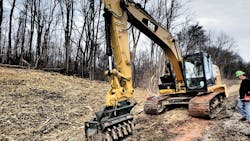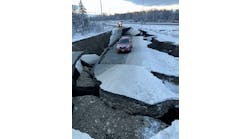The Ohio Department of Transportation (ODOT) manages the seventh-largest highway system in the U.S. This means maintaining not only 43,000 lane-miles of roadway, but also over 100,000 acres of surrounding greenspace.
ODOT’s Office of Statewide Planning and Research, along with a technical advisory panel of seasoned district managers, recently developed a research project called “Evaluating Vegetation Management Practices for Woody and Herbaceous Vegetation.”
ODOT Districts are challenged with managing native (and noxious) grass, weeds, wildflowers, shrubs and trees throughout Ohio’s diverse landscapes. By commissioning this research project, ODOT demonstrated its commitment to improving and expanding its roadside integrated vegetation management (RIVM) program.
The research team included Davey Resource Group, a division of The Davey Tree Expert Co., and the ODOT technical advisory panel. Scott Lucas, assistant administrator of ODOT’s Office of Maintenance Operations, explained, “The purpose of the project was to identify and evaluate vegetation management practices that ODOT districts could almost immediately implement to increase efficiency and cost-effectiveness, and simultaneously improve worker safety, foster safe highway use by the traveling public and improve roadside aesthetics.”
In other words, ODOT wanted to create an innovative and adaptive RIVM program that puts safety and environmental stewardship first. According to Jennifer Gulick, principal investigator for Davey Resource Group, “We first researched current industry standards, technical and academic studies and other state DOTs’ successful RIVM practices. This work revealed that if ODOT made significant changes in its herbicide use program, trained staff to more quickly identify problems and issues, and better utilized equipment, major gains in efficiency and effectiveness would be realized, and the costs for RIVM would be reduced in both the short and long terms.”
Using a system to apply herbicides and mow simultaneously reduces mowing events.
Three-point play
During the three-year project, Davey Resource Group performed thorough research components that included testing 25 chemical and mechanical vegetation management methods, holding nine field days to provide ODOT’s field staff with testing updates and new equipment demonstrations, and preparing a guide to assist ODOT staff with identifying and properly controlling prohibited noxious and problematic weeds.
The testing focused on three areas to improve ODOT vegetation management operations:
- Chemical applications: Increase targeted herbicide and plant growth regulator use and utilize an application and follow-up treatment schedule to control noxious and invasive weeds, decrease the frequency of turf mowing, brush maintenance and removal, tree trimming and removal, and maintain bare ground where needed;
- Mechanical solutions: Purchase new equipment and use existing equipment more efficiently to perform vegetation maintenance tasks more efficiently and safely; and
- Training and communication: Provide training to vegetation management personnel on plant identification, herbicide selection and timing, and encourage communication to streamline operations regarding vegetation management practices across the state.
Designed to align with ODOT’s four roadside management zones, the study addressed specific vegetation maintenance goals for each zone’s unique vegetation challenges:
- Zone One: Vegetation-Free Zone—Eliminate or reduce mowing;
- Zone Two: Operational Zone—Reduce mowing;
- Zone Three: Transition Zone—Remove noxious weeds and brush, and prevent regrowth; and
- Zone Four: Undisturbed Zone—Remove unwanted trees and prevent regrowth.
Equipment and herbicide treatments selected for testing were based on innovative vegetation management programs of other DOTs and private landscape maintenance firms. ODOT’s expectation was that the testing would reveal how to best increase operational efficiency given the diversity and challenges of roadside vegetation. ODOT expected results that would include innovative tools and techniques to decrease labor costs or time needed to perform roadside vegetation maintenance tasks, and to decrease the number of maintenance cycles needed for each growing season, ultimately decreasing ODOT’s cost to manage vegetation along Ohio’s state rights-of-way.
The 25 field tests were grouped in the four management zones. At each test site, the individual treatment method was replicated three times in a randomized design. New methods were tested against ODOT’s standard operating procedures so that costs and effectiveness could be compared. Prior to testing, time was allotted for staff training and practice on new equipment and application methods. A statistical analysis of the vegetation treatment results was performed using data collected from baseline assessments and follow-up measurements at standard intervals. Safety of the workers and traveling public, environmental stewardship and aesthetics were all considered in the testing evaluation.
Cost analyses were calculated for each test, method and treatment. The cost analyses included labor to perform the treatment and follow-up labor during the testing phase. When applicable, the purchase price of herbicides was compared. Finally, the purchase price and labor costs for new and/or specialty pieces of equipment were considered. These financial analyses provided ODOT detailed returns on investment (ROI) for each vegetation management test.
Equipment purchased and tested during the project duration included a guardrail mower with a tractor, a forestry bucket truck with 60-ft aerial boom, a whole tree chipper with a cab and loader, a skid sprayer with boomless nozzles and control panel, a skid sprayer with a hose reel and spray gun for targeted applications, a rotary boom mower system, and a batwing. Herbicide uses tested included basal bark, stump treatment, broadleaf selective herbicide, chemical side trim, grass selective herbicide, plant growth regulator, post-emergent non-selective, and pre-emergent non-selective. Testing of new equipment and variations of herbicide applications were compared to ODOT’s standard operating procedures.
According to Ruth Ann Sobnosky, co-principal investigator for Davey Resource Group, “This project was a great partnership and opportunity for Davey Resource Group staff to work directly with ODOT’s county managers to understand their real-world equipment and scheduling challenges, and with field staff during daily operations. ODOT’s insights and input throughout the study were key to the success of the project.”
During the project, field days were held throughout the state to provide updates and demonstrate equipment to ODOT field staff. Tours of the testing sites provided opportunities for staff to see results first-hand and understand what they could be doing on the job in the future.
Another practical component of this project was the development of a Guide for Roadside Integrated Vegetation Management of Prohibited Noxious Weeds in Ohio. The guide is a user-friendly field resource for identifying and controlling prohibited noxious weeds and select invasive plants found on ODOT rights-of-way.
The guide is a one-stop shop for ODOT’s RIVM personnel. In it, staff can conveniently find descriptions and seasonal photographs of problem plants, applicator reference materials, herbicide mixing and equipment calibration instructions, area and volume calculation worksheets, and ODOT reporting forms. The guide is available to view at http://daveytree.uberflip.com/i/795219-odot-guide-for-rivm.
ODOT field staff will be trained on hazard and basic tree identification, with key staff becoming certified arborists.
Ready to use
At the end of the study, data-driven recommendations with the highest return on investment for enhanced chemical and mechanical control of roadside vegetation were reported to ODOT, per the goals of each management zone:
Zone One: Achieve total vegetation control and eliminate string trimming by making three broadcast herbicide applications per year at 64 oz. per acre with a spray truck equipped with a control panel and boomless nozzles. Use a guardrail mower to maintain turf around roadside hardware to improve efficiency and reduce workers’ risk exposure where bare ground is not the objective.
Zone Two: Reduce mowing events with plant growth regulator and broadcast herbicide applications using a spray truck equipped with a control panel and boomless nozzles. Suppress early season turf height by making plant growth regulator applications at 4 oz. per acre in early spring. In late spring, control broadleaf weeds with broadleaf selective herbicide applications at 7 oz. per acre or at 5 oz. per acre. In areas not accessible by a spray truck, use a WetBlade system to apply herbicides and mow simultaneously.
Zone Three: Control noxious weeds, woody brush and small trees while promoting low-maintenance plant communities by making directed herbicide applications with a skid sprayer and spray gun. Test-specific recommendations of herbicides and application rates can be found in the final report. Use a rotary boom mower to apply herbicides and mow simultaneously. Obstructions to sight distance caused by vegetation should be mechanically removed and paired with herbicide applications to control regrowth of undesired or problematic vegetation.
Zone Four: Utilize a tree mulcher for the most cost-effective method of tree removal. Remove trees or tree limbs to prevent encroachment of the roadway using an all-terrain tree trimmer or forestry bucket truck. Control regrowth of limbs by applying herbicide with chemical side trim and skid sprayer. Follow tree removals with herbicide applications. Assign consistent staff to perform this work so that the experience gained with the equipment and methods ensures the highest efficiency.
Cheryl Daniels, project manager for Davey Resource Group, reported, “Of all the testing performed, we found that the purchase and use of new spray equipment for each county would provide ODOT the largest ROI due to the reduced mow occurrences per year.”
When the project concluded, Tom Corey, deputy director of ODOT Division of Operations, said, “This hands-on, practical research project gave us recommendations for cost-effective methods to safely and effectively maintain our rights-of-way that we could start using immediately. We feel confident now that ODOT can shift from reactive maintenance to a proactive vegetation management program for the benefit of the department and our citizens.”
As a result of this research study, ODOT has begun using new, cost-effective equipment for tree maintenance and mowing, controlling noxious weeds with directed herbicide applications, and using plant growth regulators to reduce mowing events. ODOT also is converting the Guide for RIVM into an app for mobile electronic devices, and Davey Resource Group is training ODOT’s field staff on hazard tree and basic tree identification, and is preparing key staff to become International Society of Arboriculture-certified arborists.
Turning proactive
This research project offers a wealth of valuable information and insights on improving ODOT’s approach to roadside vegetation management. Implementing the technical recommendations for treatment methods and proper timing will help ODOT efficiently carry out its mission and objectives. Armed with the data and prepared with the training the project provided, ODOT’s shift to a proactive RIVM program will directly and indirectly benefit highway users, right-of-way neighbors and ODOT, especially in these ways:
- Better-maintained roadway sight distances, reduced collision targets, increased aesthetic value, and reduced expenditure of tax dollars for roadside vegetation maintenance for highway travelers;
- Preserved or improved environmental conditions of adjacent properties, and prevention of biological pollution (e.g., noxious and invasive weeds); and
- Reduced costs for RIVM, environmental compliance, less carbon emissions from less mowing and longer maintenance cycles, safer operations for ODOT crews, and improved fleet management for ODOT.
The full study report, “Evaluating Vegetation Management Practices for Woody and Herbaceous Vegetation,” and data can be found at www.dot.state.oh.us/Divisions/Planning/SPR/Research/reportsandplans/.
Davey’s approach to developing a roadside integrated vegetation management program, like the one described in this article and now being implemented by ODOT, can be applied to any road system or other greenspace. For more information, please contact Jennifer Gulick, senior urban forest consultant, at [email protected] or Ruth Ann Sobnosky, project coordinator, at [email protected].
------------
Information for this article provided by Davey Resource Group.



